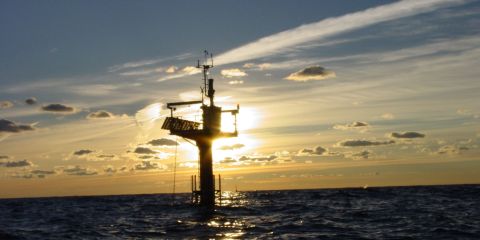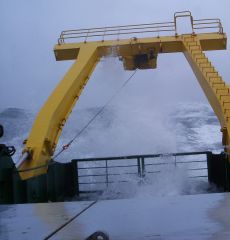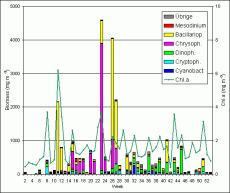

Phytoplankton development at the coastal station "Seebrücke Heiligendamm" in 2004
The results of the weekly sampling at the sea-bridge Heiligendamm (54°08,55' N; 11°50,60' E, 300 m off shore, 3 m water depth), performed by the Baltic Sea Research Institute Warnemünde (IOW) are shown in Fig. 1.
The line reflects the chlorophyll a concentration and the columns the phytoplankton wet weight.
The phytoplankton biomass was determined by microscopic counting and the chlorophyll a concentration by ethanolic extraction and fluorometric measurement according to the HELCOM manual
(http://www.helcom.fi/Monas/CombineManual2/CombineHome.html).
Quantitative microscopic counting was not possible in week 3, 4, 7, 22, 29 and 48 due to high content of resuspended sediments in the samples owing to strong wind.
As expected, phytoplankton biomass was low in January and February. Only on 17.2.04 (week 8) a relatively high amount of Cryptophyceen (Teleaulax spp.) occurred, besides of the dinoflagellate Heterocapsa rotundata. On 9.3.04 (week 11), the spring bloom reached its peak. It was dominated by Thalassiosira nordenskioeldii (1473 mg m-3), besides of much lower biomasses of Skeletonema costatum (101 mg m-3), Chaetoceros cf. debilis (93 mg m-3) and Porosira glacialis (67 mg m 3). Already by the 17.3.04, Thalassiosira nordenskioeldii dropped to 87 mg m-3, while the biomass of Skeletonema costatum grew to 305 mg m-3. On 23.3.04 (week 13), the bloom was over, which was also indicated by the chlorophyll a data. In the year 2003, the spring bloom occurred much earlier (on 26.2.03) and was dominated by Skeletonema costatum (= 1662 mg m-3). The biomass of the photoautotrophic ciliate Mesodinium rubrum stayed low, like in 2003. On 6.4.04, the naked form of the chrysophyceae Dictyocha speculum occurred with 429 mg m-3. The stayed the dominant or sub-dominant species until 29.6.04 (week 27). The big diatom Dactyliosolen fragilissimus has developed strongly since 2.6.04. It grew to a peak biomass of 2757 mg m-3 by the 22.6.04 (week 26) but disappeared almost completely by the 6.7.04 (week 28). It was replaced on 20.7.04 (week 30) by the big diatom Cerataulina pelagica (316 mg m-3). It decreased to 56 mg m-3 on 3.8.04, while the summer cyanobacteria Nodularia spumigena, Aphanizomenon sp. and Anabaena spp. developed. However, in contrast to the previous year the cyanobacteria did not form a bloom. On 10.8.04 (week 33), the cyanobacteria Nodularia spumigena, Aphanizomenon sp. and Anabaena spp. have already decreased. Also the summer diatoms (Cerataulina pelagica, Proboscia alata, Dactyliosolen fragilissimus) disappeared, whereas the slow growth of the typical dinoflagellaten Ceratium tripos continued. Cryptophyceae (Plagioselmis prolonga) developed, too. All species decreased by the 24.8.04 (week 35). Dinoflagellates (Ceratium tripos, Prorocentrum micans, Heterocapsa rotundata) appeared in high biomass on 31.8.04 but decreased already in the next week. Surprisingly, Nodularia spumigena reappeared in week 37 but disappeared finally in week 39 (21.9.04). Dinoflagellates (Ceratium tripos, C. fusus, Prorocentrum micans) continued their growth. A bloom of the potentially toxic diatom Pseudonitzschia multiseries und Pseudonitzschia pseudodelicatissima(357 mg m-3) is remarkable because it is not usual. At the same time (5.10.04, week 41), also Cerataulina pelagica, Guinardia flaccida and Ceratium tripos were frequent.
The typical autumn dinoflagellates (Ceratium tripos, C. fusus, Prorocentrum micans) dominated on 19.10. and 2.11.04 (week 43 and 45). Afterwards, their biomass decreased drastically. Nevertheless, the diversity was rather high in mid of December, with more than 40 identified taxa. It was mainly formed by diatoms (Proboscia alata, Guinardia flaccida, Thalassiosira anguste-lineata, Thalassionema nitzschioides, Chaetoceros curvisetus, Ditylum brightwellii, Cerataulina pelagica), dinoflagellates (Ceratium tripos, Heterocapsa rotundata) and cryptophyceae (Teleaulax sp., Plagioselmis prolonga).
IOW, 23.09.2005
Dr. Norbert Wasmund,
Susanne Busch,
Ina-Marie Topp,
Regina Hansen.

State of the Baltic Sea
- Annual Reports on the state of the Baltic Sea Environment
- Cruise Reports
- Data from the autonomous measuring stations
- Development of the suboxic and anoxic regions since 1969
- Baltic Thalweg transect since 2014
- Algal blooms at Heiligendamm since 1998
- "Major Baltic Inflow" December 2014
- "Major Baltic Inflow" January 2003
- Baltic saline barotropic inflows 1887 - 2018
- Further Reading

